Mindful Touch Can Modify the Brain’s Functional Connectivity
Touch is an important communication channel for humans that is key to manual therapy. Several studies have demonstrated that the stimulation of sensory/afferent touch fibers activates specific brain areas in the person (subject/client) receiving the touch stimulus. We also know that the activation pattern of our central nervous system is influenced by the attention that we pay while receiving the touch.
Beyond this, personal experience suggests that when we receive a massage, a pleasant caress, a pat on the back, or a handshake, that we can also perceive the emotional state of the person (touch giver/ therapist) who is giving the touch. However, no research has actually investigated the effect on the person’s / client’s brain by the intention of the therapist who is giving the touch.
Study – Mindful Touch versus Non-Mindful Touch
Thus, a study from Chieti, Italy, investigated brain connectivity while clients were receiving a static touch by a touch giver who was focused on either the touch that they were giving (in other words, they were practicing “mindful touch”) or a sound that they were hearing while giving the touch (in other words, practicing “non-mindful touch”).
The study was a randomized-controlled single-blinded study with 40 healthy right-handed adult participants. The effect of touch on the client’s brain was monitored using functional magnetic resonance imaging (fMRI).
The clients were randomly assigned to one of the two touch treatment groups:
- Therapist focusing on tactile perception from the hands (mindful touch group)
- Therapist focusing on auditory stimuli (non-mindful touch group / sound focused group).
The therapists in the mindful touch group were asked to focus their attention on the feeling/perception from the hands that were contacting the client, i.e., the therapist had to feel the client’s tissue regarding its consistency, density, temperature, responsiveness, and motility (e.g., myofascial movements).
The therapists in the sound-focused (non-mindful touch) group were asked to direct their attention toward acoustic stimuli (beeps) that were delivered through headphones. These beeps were delivered at a random interval between 0.5 seconds and 2.0 seconds; and the therapist had to count the number of beeps per session.
Results
The results revealed that sustained static touch applied by a therapist resulted in significant differences in brain activity of the person receiving the touch depending on whether the person giving the touch was focused on the touch or focused instead of random beeping sounds. Tthese changes were noted in connectivity between regions of the clients’ brains known as the posterior cingulate cortex, insula, and inferior-frontal gyrus.
These functional connectivity changes are markedly different only after 15 min of touching. In other words, if the therapist is mindful and sustained over time, it can elicit significant effects in the client’s functional brain connectivity between areas processing the interoceptive and attentional value of touch.
Comment by Joseph E. Muscolino
In one sense, the outcome of this study is somewhat intuitively obvious. That is that a client would experience differently a treatment that is given by a therapist who is performing a mindful massage versus a therapist who is performing a non-mindful massage. Having said that, it is nice to confirm our intuitive feelings. And it is gratifying to begin to qualify and quantify exactly where in the nervous system we experience these differences.
But the practical implications are clear: clients can tell the difference between the massage of a therapist who is mindful, present, and connected, and the massage of a therapist who is distracted and delivering pro-forma, cookbook, mediocre massage. This should serve as a wakeup call to therapists. I am sure that we all aspire to be the best therapists we can be, both for the benefit of our clients and for the benefit of our practice. And this requires being present and delivering to our clients the quality mindful touch that they deserve to receive and that we as professionals should have the integrity to give!
This blog post article was created in collaboration with Dr Joe Muscolino



